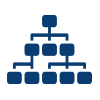Knowledge Discovery Metamodel History
History of the development and evolution of the KDM.
Read more » The Knowledge Discovery Metamodel (KDM) is a publicly available specification from the Object Management Group (OMG). KDM is a common intermediate representation for existing software systems and their operating environments, that defines common metadata required for deep semantic integration of Application Lifecycle Management tools. KDM is designed as the OMG’s foundation for software modernization, IT portfolio management and software assurance.
The Knowledge Discovery Metamodel (KDM) is a publicly available specification from the Object Management Group (OMG). KDM is a common intermediate representation for existing software systems and their operating environments, that defines common metadata required for deep semantic integration of Application Lifecycle Management tools. KDM is designed as the OMG’s foundation for software modernization, IT portfolio management and software assurance.
KDM is a metamodel for knowledge discovery in software. It defines a common vocabulary of knowledge related to software engineering artifacts, regardless of the implementation programming language and runtime platform – a checklist of items that a software mining tool should discover and a software analysis tool can use. KDM is designed to enable knowledge-based integration between tools. More specifically, KDM uses Meta-Object Facility (MOF) to define an interchange format between tools that work with existing software as well as an abstract interface (API) for the next-generation assurance and modernization tools.
The KDM specification has been developed since 2003 by a consortium of companies interested in architecture-driven modernization and knowledge discovery in software engineering artifacts. Currently, Dr. Nikolai Mansourov is chairing the OMG Revision Task Force for Knowledge Discovery Metamodel (KDM RTF).
KDM Analytics is committed to supporting the growing KDM ecosystem – a community of tool and component providers and service providers whose products interoperate because they share common ontology defined by the Knowledge Discovery Metamodel (KDM).
History of the development and evolution of the KDM.
Read more »A detailed technical overview of the Knowledge Discovery Metamodel and its architecture.
Read more »Our views on why the KDM is so powerful - and why we're committed to it.
Read more »Learn about the challenges of software analytics tools, interoperability & technology challenges.
Read more »